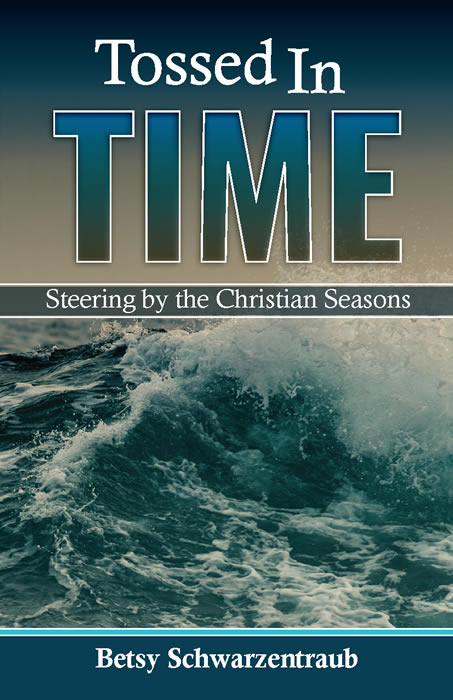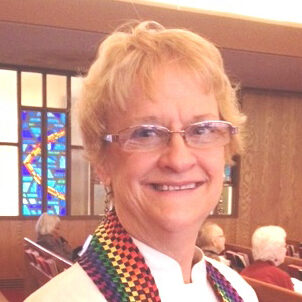Tossed In Time: Steering by the Christian Seasons
By Betsy Schwarzentraub

Just marking time after the lockdown?
It’s easy to feel lost at sea, stripped of a sense of meaningful movement through time, when so many social anchors have been torn away due to the recent pandemic.
Myriad activities that provide a sense of community are suddenly gone, as well as special celebrations with families and friends. For those who want to follow Jesus, worst of all can be the loss of in-person worship to anchor the week and a sense of significance from one day to the next.
Many people yearn to make a closer connection between a life of faith and their daily rhythms, including how to:
- Gain a sense of personal meaning from the time patterns of the ancient worship seasons
- Experience authentic worship, whether with a congregation or as a family at home
- Anchor their passage of time in the Christian Year regardless of public gatherings.
♦♦♦
Tossed in Time introduces people to the ancient Christian seasons to help them reshape their sense of time and find their place in a larger Story. Peter’s experience of walking with Jesus on the stormy sea begins this book and ties the chapters together. Reflection questions and at-home activities help readers live by a rhythm that follows the life of Jesus, discovering a pattern that can infuse each day with meaning.
Link to Reviews:
Excerpt from Tossed In Time: Steering by the Christian Seasons
Lost at Sea
Peter Reflects on the Storm:
It’s amazing how afraid we were on the water that night, the four of us fishermen. All our lives, we’d seen those storms sweep over Galilee, but usually it was from the safety of shore. All the same, that storm was far worse than just any squall. In the middle of the night, no less. What would become of us?
I know every day we live is a gift from God. But when a frightening time comes, when everything we’ve been comfortable with has been thrown overboard, it’s easy to lose our way and lose track of what gives us a sense of what is normal. When I hurt or I’ve lost people I care about, it feels like a great stone weight.
&&&
They must have been able to taste their fear that night, in their fragile boat in the windstorm on the Sea of Galilee. Yes, four of the twelve disciples (“guys,” as Peter might have called them), fishermen by trade, had been out on the lake all their lives. But they were all past the point of exhaustion, battling the wind and waves in the deepest part of the night. As if that wasn’t bad enough, they were sure a ghost was out there stalking them. It’s a wonder they didn’t give up altogether.
So what about a virus that suddenly sweeps in like a storm and swirls all around the globe? Millions of people have been infected. Millions of people have died. Millions more have lost jobs, businesses, savings, or homes. With grim reports assailing us, we may be able to taste our fear during and after these pandemic times, as we try to keep our personal boat afloat – our long-term health, our livelihood, our families and friends, our relationships with others – even as we continue to shelter in place, fearful of even more powerful variants that might follow.
While many parts of the world may still be countering deathly blows from the initial pandemic, people in more economically privileged countries can be fitfully emerging from the pandemic lockdown. But as each society reopens, individuals may continue to see themselves alone, as if piloting their own little vessels through the uncertain waters.
Living beyond the first waves of the COVID-19 pandemic, we can feel as if a multi-dimensional storm has rushed down on us. Just grappling with a single dimension of it – a sense of meaningful movement through time – can be overwhelming. Time itself is a gift from God – but we can experience it like an adverse wind pushing against us. It may throw us into wild waves, in a desperate search to keep busy, or else into a deadly stillness that isolates us in doldrums. So many group activities have been suspended because of the pandemic. Thousands are unable or afraid to go to in-person work, stores, restaurants, movies, or gatherings of friends. They have lost their social bearings.
If we have children or grandchildren, we may be trying to home-school them while working fulltime there as well – that is, if we still have a job. We are unable to celebrate cherished traditions in birthdays and holidays with families. And a myriad small social interactions that provide a sense of community are gone: physical activities, gatherings with friends, attending community events, visiting the library.
Just as important, our time milestones for the year have disappeared, as well. The entire calendar is shorn of its moorings.
For those who try to follow Jesus, worst of all can be the loss of in-person, weekly worship to anchor the rest of the week and to remind us of our faith – our “trust” – in the God who is the Master of all, including life’s winds and waves. Whether we used to go to church every Sunday, or we didn’t attend church all that often but knew it was there, it was an option. Church gave a sense of safe haven when we were buffeted by life’s storms. But now, dealing with a pernicious global virus and its uncertain aftermath, how can we re-shape our sense of time when so many social markers have been lost in the immediate, life-threatening tumult?
Tossed about in this way, we may find the word “tumult” to describe what many of us feel we are going through. The term can mean havoc on at least three levels. First, it could be an uproar: a violent commotion or disturbance. Second, it might be a general outbreak or uprising. Third, it may describe a highly distressed mind or set of emotions. A silent but deadly virus can create such an upheaval externally, with citizens scrambling for medical care or protesting government fiats. Third, such turmoil also can create unrest and turbulence within persons, as we work emotionally and spiritually to get our time bearings once more – what times to value and what events to celebrate along the way. In all three understandings of the word, our sense of meaningful time is tossed overboard.
Alternatively, getting caught “adrift” on the open sea can be just as deadly as the stirred-up gale itself. A boat adrift with no horizon in sight can mean slow death for the people aboard, if they’re unable to steer by the stars or to communicate with other vessels to get back to land. Likewise, those who remain can get caught in eddies of grief after the loss of those they cared for, or locked into the more complicated laments when the ones they have lost had refused to take the vaccine.
At the same time, even if life on the surface seems smooth at any given moment, what might be moving through the watery depths below us can be even more lethal than the original storm. The initial strain of a virus can mutate and attack us unawares. Survivors of an initial virus surge may fear continued vulnerability to a more resistant variant. Or they may become so accustomed to isolation or steeped in distrust of others that they lose their sense of human community.
In addition, they might lose their faith in God, or their sense of purposeful movement through the times of their lives.
Casting about for a meaningful guide in all this confusion, we can look to a different calendar altogether. It offers a sense of foundational rhythms that hold our lives together. The Christian Year has worship seasons that are so ancient they are new to almost all of us. Keeping our sites on these seasons can offer personal bearings even when we’re far out on the unpredictable sea – as one song says, when we’re “out in the water and the bathtub is gone.”
Life is dynamic and fluid even in the calmest of times. A message from an old hymn reminds us, “When the storms of life are raging,” Jesus Christ always stands with us.
How to Use This Book
As a reader, you can use Tossed in Time in different ways, depending on your circumstances. First read “After the Storm.” Then you could:
- Begin on the first page. Whatever season of year you pick up the book, start at the beginning. Take as much time as you want to explore the ideas, questions, and things to do. You might also feel led to journal, or to send a note to someone who comes to mind related to one of the chapter’s themes.
- Go by the month of the year you are in – Note the times at the top of each chapter. See if there are special days or themes within that period that take on a different or deeper meaning for you. Consider doing an activity that might become a habit or ritual to help you remember what’s important about this time.
- Pick and choose – Look through the themes in the Table of Contents and see what jumps out at you. Focus on that theme for the day, or the week, or the month. Note how your understanding is challenged, affirmed, or expanded. Find a way to celebrate what it means to you in your home life or personal perspective on the world.
- Start at the beginning of a cycle, in Advent or in Lent. Consider how your belief or involvement can develop from Advent to Christmas to Epiphany, or from Lent to Easter to Pentecost. Bible passages are listed just for those who want to follow up on a thought, not for argument or “proof.” Don’t let religious terms get in the way; look for emotions that are revealed in each part of the cycle. Think how the themes may give a sense of connection to this time in your life.
However you choose to use this book, I hope it offers you some essential bearings in the midst of what otherwise could be a frightening time. May you rediscover Jesus Christ as Someone to trust, establish some seasonal markers as you go along, and find ways to celebrate these occasions as you dare to experience the time of your life.
Betsy Schwarzentraub


